Acer
Acer Predator Triton 700: a good radiator for winter
Aprox. 2916€ - see price -
See specificationsThe Acer Triton 700 is the second portable PC benefiting from the "Nvidia Max-Q" design to come to our lab. A few weeks after the Asus ROG Zephyrus, this new gaming notebook promises a video game experience that is both mobile and without compromised, thanks to a GeForce GTX 1080 graphics card, a thickness of 18.9 mm and a weight of 2.6 kg.
Our review
Construction
Like the recently tested ROG Zephyrus, the Acer Triton 700 opts for bold design biases, linked to the constraint of Max-Q design. At first glance, before opening its hood, nothing very original appears: the all-aluminum chassis is sober and benefits from a fairly successful gloss treatment, pleasant to the touch, but somewhat messy. For a laptop dedicated to video games, we must admit that this Triton 700 remains discreet, and we will not complain. Given its price range, it is also not surprising to find a very good level of finish and impeccable build quality.
It is by discovering the screen and the input area that we notice the surprising design choices made by Acer. The first thing that stands out is the lack of a touchpad under the keyboard. It is indeed integrated in the wide strip of Gorilla Glass just above, where the graphics card is notably wedged. Without a dedicated mouse, it is therefore compulsory to seek the pointer by extending the arm, which is far from practical. But this is not the main problem, because the graphics card, integrated just under this glass surface / touchpad, invariably heats up and then raises the temperature of the touchscreen very high, which becomes almost unusable when a game a while either undemanding turns.
The Triton 700 is therefore a notebook that is used almost exclusively with a mouse, its touchpad being both very badly placed and almost dangerous to use under certain conditions. In addition, the absence of physical buttons and differentiation between the left click and the right click require hazardous and frankly imprecise manipulations.
The balance sheet is however a little more positive when you put your hands on the keyboard, with mechanical keys and backlit in RGB. The race is quite long and the typing pleasant and precise, but one can be embarrassed by the inevitable sound of the keys which sink. In addition, this keyboard is found very much forward on the chassis and the comfort at the wrists is not really there.
The Triton 700 is well provided with connectors and Acer has sacrificed nothing in favor of the finesse of the chassis. There are three USB 3 Type-A ports, a USB 3.1 / Thunderbolt Type-C port, an HDMI output, a DisplayPort, a Gigabit Ethernet port, as well as two jack sockets for headphones and a microphone. We still regret the absence of an SD card reader.
To finish this review of the design and construction of the Triton 700, let's talk about noise and the level of heating. As a reminder, this notebook has the "Max-Q Design" label from Nvidia, which allows you to enjoy a high-end graphics card in a thin chassis (here 18.9 mm thick). Unlike the ROG Zephyrus, a very good student in heat dissipation and noise management, the Triton 700 struggles to convince on these two points. As we mentioned above, the temperature can reach very high values: 62.1 ° C at the glass touchpad, 65.4 ° C at the back and 69.3 ° C under the hood. Something to keep warm for the winter. This observation is especially made during a session of a recent game in 3D, and the whole is accompanied by a ventilation which releases up to 47 dB (whisper mode deactivated). The breath emitted is therefore very audible and can be really annoying if you use the Triton 700 without headphones or in the presence of other people.
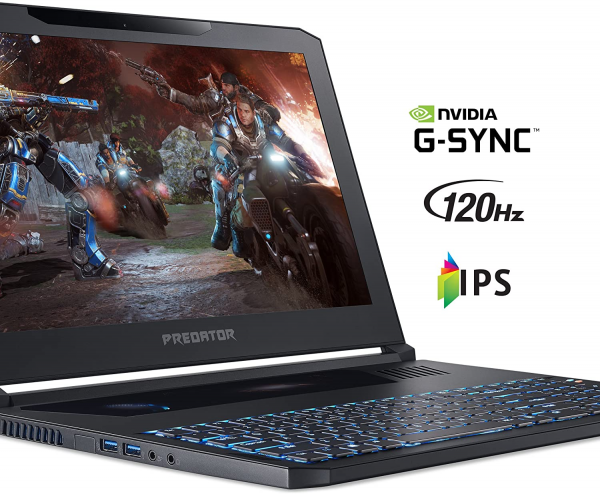
Screen
The Acer Triton 700 is equipped with a 15.6-inch (39.6 cm) IPS mat panel, displaying a Full HD definition (1,920 x 1,080 px). As on many laptop screens for recent gamers, the refresh rate goes up to 120 Hz and G-Sync compatibility is there.
Once our probe is applied, we see very good results, and in the good average of PCs with IPS matte panels in 15 inch format. The contrast ratio thus rises to 960: 1 and the maximum brightness is set at 330 cd / m². However, the calibration lacks precision, with a delta E (difference between the actual colors and the displayed colors; it is considered very good below 3) at 4.3 and a color temperature which rises to 8 270 K, with as a result a rendering slightly favoring cold shades.
delta color E = 4.3 gamma 2.2 temperature 8270 K
We are however very disappointed with the afterglow of the screen, which reaches 24 ms. A very bad score, even more so for a laptop PC equipped with a GTX 1080 and a 120 Hz panel. For this type of gaming PC, the ideal is to have a latency of less than 10 ms, certainly still difficult to find on notebooks. Either way, 24 ms afterglow is unacceptable.
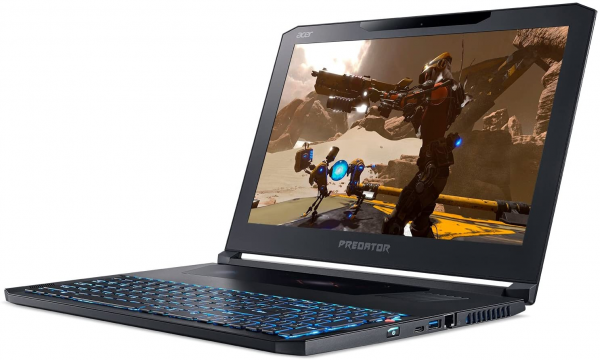
Performances
The Acer Triton 700 is particularly well equipped. Our test model includes an Intel Core i7-7700HQ processor, 32 GB of DDR4 at 2400 MHz and two 1 TB SSDs mounted in Raid 0. What hope for an excellent level of performance, which was verified during our various benchmarks based on 3D calculation, audio and video conversion, file compression and photo editing.
The Triton 700 thus reaches a high power index, comparable to that of the Asus ROG Zephyrus and consistent with what usually delivers an Intel Core i7-7700HQ. This is the kind of configuration that allows a wide variety of uses in excellent conditions. For office, web, video editing or photo editing, the Triton 700 does the trick.
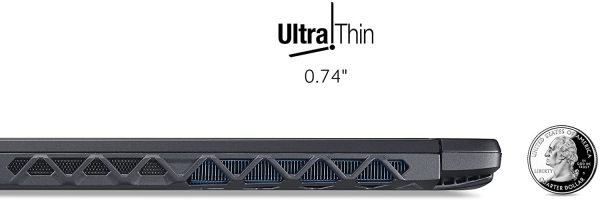
Games
The Nvidia GeForce GTX 1080 graphics card (8 GB of video memory) which equips the Triton 700 is a "Max-Q Design" version: in order to be able to function properly in a chassis less than 2 cm thick, its frequencies clock have been lowered. Our power index based on 3D Mark shows however a large advantage of the Triton 700 over the ROG Zephyrus, and a gap almost zero with the Predator 17X, also equipped with a GTX 1080 but devoid of "Max-Q Design".
A very positive observation therefore, and we no longer find ourselves in front of a GTX 1080 as on the Zephyrus. In game, the results are very good and we reach very easily 70 frames / second in Full HD - or even more on certain titles - at the highest level of detail. We noted 74 fps on Metro: Last Light, 73 fps on Rise of The Tomb Raider, 72 fps on The Witcher 3 (hairworks x4), 75 fps on Crysis 3 or 146 fps s on Star Wars: Battlefront.
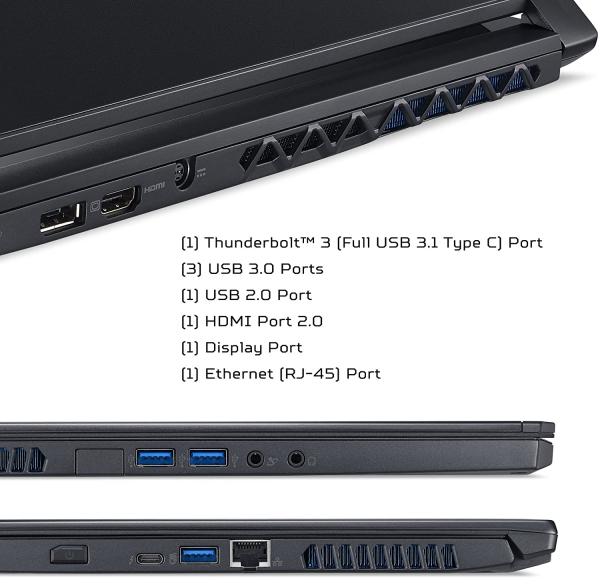
Mobility / Autonomy
On the question of autonomy and transportability, the Predator Triton 700 is full of contradictions. We appreciate its weight of 2.6 kg and its thickness of 18.9 mm, which allow easy transport in a medium-sized bag, but you have to do it with a charger which still remains quite bulky and, above all, a frankly disappointing autonomy. If the video game is only possible for 1 hour to 1 hour 30 minutes (this is not really a surprise), our streaming video playback test (Netflix in Chrome, headphones plugged in, backlight off) has not exceeded 1 hour 38. A very low figure, even for a gaming laptop in 15 inch format. Office-oriented use, using energy saving, will be possible for 4 hours, no more.
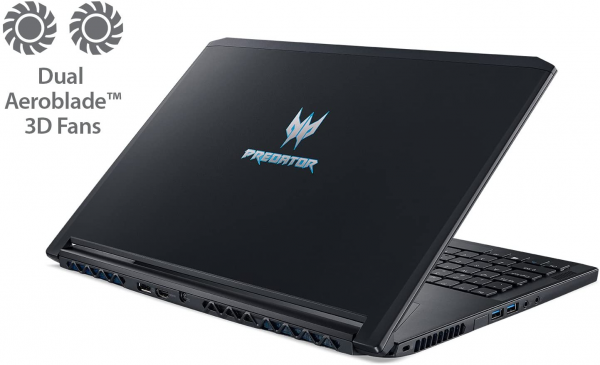
Audio
The headphone output of the Triton 700 is good. There is a fairly low distortion rate (0.01%) and a good output power (150 mVrms). The whole spectrum is well rendered and the listening experience is quality.
A technical problem prevented us from applying our usual test protocol for loudspeakers. By ear, they deliver a decent sound for a notebook, but the rendering seriously lacks bass and treble, focusing mainly on the mids.
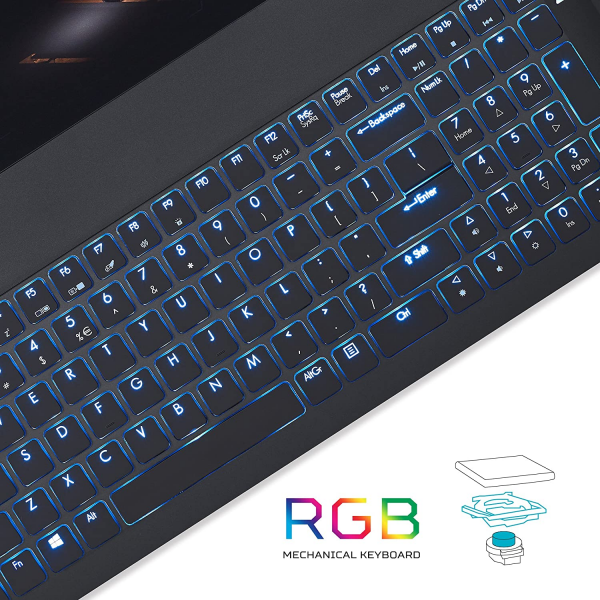
Conclusion
The first Acer "Max-Q" laptop blows hot and cold ... Finally, especially hot, given its ability to rise very high in temperature in completely inappropriate places. The design choices made by the manufacturer are strange and often unwise, making its use almost impossible without a mouse. If we add to this a too low autonomy and a remanence time of the panel far too high for a gaming product, we obtain a notebook certainly very powerful and easily transportable, but which struggles to convince.

Specifications
Reviews

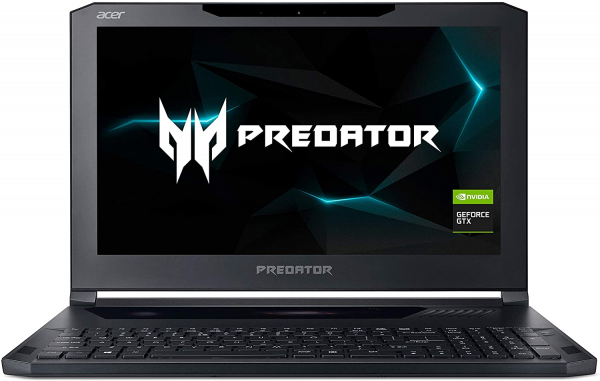
Solid build professional gaming NB - overclockable, 3 external displays, sweet mechanical KB, and killer double shot Pro.
Notebook build quality is solid and stiff, just like what I expect on the high end system, with alloy LCD lid / Cover and body. The keyboard tray has barely any flex to it, very different from the MSI Stealth Pro that I have, albeit the Stealth Pro was much cheaper (GTX1060).
I absolutely love that clicky sound, and tactile feel from the mechanical KB. The KB is not a full depth Corsair KB (K70) that some of my friends have, but I like the Triton 700 KB more than any low profile notebooks' (including the Stealth Pro) that I have had over the years. I do wish that that there's some texture on the WASD keys.
Performance is legit. Overclock is easy, just open the Predator Sense, and there are two additional level of OC to choose from. I don't know why the middle settings. I've ran GPU-Z to check the clock speed, Boost shows up at 1618Mhz, and the log file actually even reached above 1700Mhz often (Turbo with Max Fan, on some games). Default clock speed on mine was 1290Mhz before OC.
Max Q design: I like how quiet the Max Q GTX1080 in terms of quietness. However, what I enjoyed more is the ability to overclock both the GPU and GPU memory. After all, I (my wife, actually) paid for a GTX1080, I get to decide what I want my rig to do. I've turned on Max Fan, blasting the fans just under 5K RPM with turbo, with audio at a decent level, it was a sweet. My wife didn't like what I did, but she lets me have this cool toy, I have to push it from time to time.
Heat: The top portion, or the touchpad area did run a bit warm with CoolBoost off, especially near the left, after about 40 min of game play on Nvidia Surround View with 5760x1080 under the default setting, before opening up Predator Sense. There was an update after I opened up Predator Sense. It recommended me to keep “CoolBoost” on. After having the “CoolBoost” on, the system feels acceptable. However, on occasion, the fan seems to run faster (slightly louder) than when I turn off “Cool Boost.” Without “Cool Boost,” it seems like the Fan RPM is stuck at just above 3K +. So far, I decided to keep the “Cool Boost” on constantly.
It's pretty awesome that this beast is powerful enough that it can easily drive 3 external FHD displays and have the ports for it. But, because my LCDs did not have Type-C port, I had to use a Type-C to HDMI dongle. That's minor. Surround View is what I miss the most when I go to my friends' house to play. They are too cheap to have extra displays waiting for me. You might have to play with which display is which when setting up Surround View.
One last point that I like to share, and, this might sound stupid, but I think it's really cool to have RJ45 built into the system, especially for a gaming notebook this thin. I lost my HDD with all my game files. This saved me a bit of time downloading my titles. If I play competitively, I would think that a Lan line is important. [Those Darn Squirrels]
I am really impressed with what this beast can do. Oh, and if you like to game, buy yourself a decent mouse. I am eyeing a Corsair M65 to replace my current mouse. Maybe my wife will see this review, and surprise me again.
Has its drawbacks, but I think they're not too relevant in context
Pros:
* Sleek and light (considering the specs)
* Great performance (not sure if as fast as a desktop-class GTX1080, but it definitely has little to no trouble maxing out any game).
* Good screen (high refresh rate, reasonable resolution for the size, I have noticed no ghosting and no brightness hotspots)
* Nice integrated keyboard (mechanical, clicky, much better than a traditional membrane keyboard)
* No thermal throttling issues that I've noticed so far
* Good variety of ports available
Cons:
* The trackpad is beautiful, but not practical
* The mechanical keyboard has less travel than a desktop mechanical keyboard, negating some of its perks
* The fans can be whiny and noisy, and it still tends to get a bit hot (especially the glass trackpad)
* The speakers are bad, lack bass
* Terrible battery life, even my GT80 Titan lasts longer (at least in stock config. I'm still playing around with it)
* Definitely expensive for the specs (you're paying a lot for the compact design)
All that being said, you'll probably use this laptop with its power adapter, a mouse and headphones, since it's a gamer laptop. That pretty much negates most of the drawbacks for its target audience: people who travel a lot and play games on their destinations.
a beast
it's a beast. it will run anything you throw at it maxed out at 1080p silky smooth with all settings maxed out. the fans do spool up audibly under load but you'll most likely be using headphones with this so you won't hear them anyway. The headphone jack also puts out some serious power, if you plug your heaphones direcly into the laptop headphone jack they will be plenty loud for gaming or anything else. This thing also feels well constructed and is built like a tank. i wouldnt try it but it feels so well built that i think it would survive a drop on solid concrete. it's a lot thinner that i expected. Is it worth 3k? i don't know, if you don't want to be couped up in a room all the time while gaming then yes, i think so. You can go game on the road, game on the porch, game in the kitchen, game at the library, game anywhere with a power outlet, etc without losing any performance from a top of the line desktop pc. Only thing that is lacking is a larger HDD (512gb fills up fast), and i wish the WASD keys had some texture on them. Overall it is a Great product and i have no regrets so far.